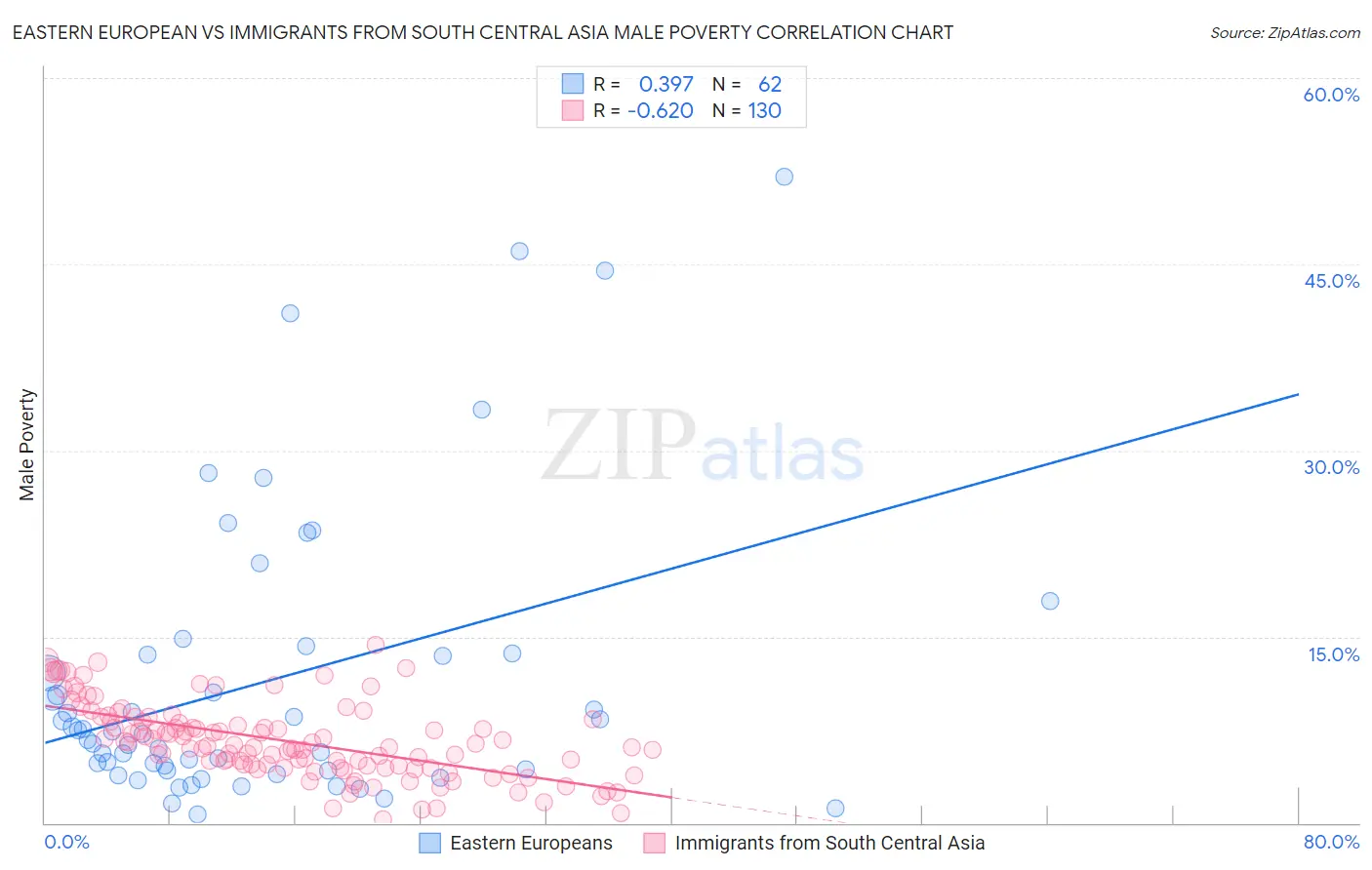Eastern European vs Immigrants from South Central Asia Male Poverty
COMPARE
Eastern European
Immigrants from South Central Asia
Male Poverty
Male Poverty Comparison
Eastern Europeans
Immigrants from South Central Asia
9.6%
MALE POVERTY
99.6/ 100
METRIC RATING
25th/ 347
METRIC RANK
9.3%
MALE POVERTY
99.9/ 100
METRIC RATING
9th/ 347
METRIC RANK
Eastern European vs Immigrants from South Central Asia Male Poverty Correlation Chart
The statistical analysis conducted on geographies consisting of 460,627,341 people shows a mild positive correlation between the proportion of Eastern Europeans and poverty level among males in the United States with a correlation coefficient (R) of 0.397 and weighted average of 9.6%. Similarly, the statistical analysis conducted on geographies consisting of 472,354,703 people shows a significant negative correlation between the proportion of Immigrants from South Central Asia and poverty level among males in the United States with a correlation coefficient (R) of -0.620 and weighted average of 9.3%, a difference of 4.0%.

Male Poverty Correlation Summary
| Measurement | Eastern European | Immigrants from South Central Asia |
| Minimum | 0.67% | 0.33% |
| Maximum | 52.0% | 14.4% |
| Range | 51.3% | 14.0% |
| Mean | 11.4% | 6.6% |
| Median | 7.3% | 6.2% |
| Interquartile 25% (IQ1) | 4.3% | 4.6% |
| Interquartile 75% (IQ3) | 13.5% | 8.4% |
| Interquartile Range (IQR) | 9.3% | 3.8% |
| Standard Deviation (Sample) | 11.6% | 3.0% |
| Standard Deviation (Population) | 11.5% | 3.0% |
Demographics Similar to Eastern Europeans and Immigrants from South Central Asia by Male Poverty
In terms of male poverty, the demographic groups most similar to Eastern Europeans are Swedish (9.6%, a difference of 0.14%), Italian (9.6%, a difference of 0.22%), Croatian (9.6%, a difference of 0.23%), Burmese (9.7%, a difference of 0.44%), and Immigrants from Scotland (9.6%, a difference of 0.48%). Similarly, the demographic groups most similar to Immigrants from South Central Asia are Bulgarian (9.3%, a difference of 0.56%), Filipino (9.2%, a difference of 0.79%), Bolivian (9.4%, a difference of 1.2%), Immigrants from Bolivia (9.4%, a difference of 1.3%), and Immigrants from Lithuania (9.4%, a difference of 1.4%).
| Demographics | Rating | Rank | Male Poverty |
| Immigrants | Ireland | 99.9 /100 | #7 | Exceptional 9.1% |
| Filipinos | 99.9 /100 | #8 | Exceptional 9.2% |
| Immigrants | South Central Asia | 99.9 /100 | #9 | Exceptional 9.3% |
| Bulgarians | 99.9 /100 | #10 | Exceptional 9.3% |
| Bolivians | 99.9 /100 | #11 | Exceptional 9.4% |
| Immigrants | Bolivia | 99.9 /100 | #12 | Exceptional 9.4% |
| Immigrants | Lithuania | 99.9 /100 | #13 | Exceptional 9.4% |
| Immigrants | North Macedonia | 99.8 /100 | #14 | Exceptional 9.4% |
| Bhutanese | 99.8 /100 | #15 | Exceptional 9.5% |
| Luxembourgers | 99.8 /100 | #16 | Exceptional 9.5% |
| Norwegians | 99.8 /100 | #17 | Exceptional 9.5% |
| Lithuanians | 99.8 /100 | #18 | Exceptional 9.5% |
| Immigrants | Hong Kong | 99.7 /100 | #19 | Exceptional 9.6% |
| Latvians | 99.7 /100 | #20 | Exceptional 9.6% |
| Immigrants | Scotland | 99.7 /100 | #21 | Exceptional 9.6% |
| Croatians | 99.7 /100 | #22 | Exceptional 9.6% |
| Italians | 99.7 /100 | #23 | Exceptional 9.6% |
| Swedes | 99.7 /100 | #24 | Exceptional 9.6% |
| Eastern Europeans | 99.6 /100 | #25 | Exceptional 9.6% |
| Burmese | 99.6 /100 | #26 | Exceptional 9.7% |
| Danes | 99.6 /100 | #27 | Exceptional 9.7% |